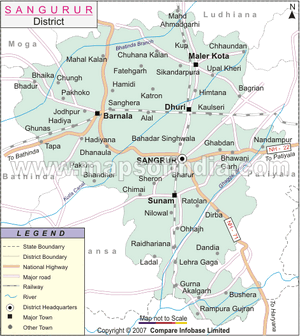Dhanaula

Dhanaula (धनौला) is a city in Sangrur district in Punjab.
Location
Situated 18 km west of Sangrur, Dhanaula lies on the Sangrur-Barnala road. It falls in the Barnala District and is about 12 km from Barnala.
History
Dhanaula was founded by Gurditta, eldest son of Tiloka, in V.S. 1775 (A.D. 1718). It was the capital of the erstwhile Princely State of Nabha until 1755 when Raja Hamir Singh founded Nabha town and made it the capital of the State. He also built a fort which now houses the police station of Dhanaula.
Jat Monuments

This fort was built by Sandhu Jat Jagirdar Sardar Ganda Singh Sandhu of Dhiromajra in late 19th century.
धनौला किला, धीरो माजरा, संगरूर (पंजाब)। यह किला 19 वीं शताब्दी के अंत में धीरो माजरा के संधू जाट जागीरदार सरदार गंडा सिंह संधू द्वारा बनवाया गया था।
The division of the estate of Chaudhari Tiloka
Lepel H. Griffin writes:[1]The Nabha Chiefs claim precedence over the other Phulkian houses on account of their descent from the eldest branch of the family. The histories of Pattiala and Jhind have contained an account of the common ancestor Phul, and of his two sons Gurditta and Sukhchen, from the elder of whom the Nabha house has sprung, and from the younger the house of Jhind.
On the death of Tilokha, in 1687, his estate was divided between his sons. Gurditta married the daughter of
Sirdar Sardul Singh Man of Mauran, who bore him one son, Suratya. He founded the village of Dhanaula or Dhandla, on that portion of the estate of his father that fell to his share, and, subsequently, the town of Sangrur, which remained the head quarters of the Nabha State, till seized by treachery by the Raja of Jhind, and he also took from his neighbours a considerable portion of the surrounding country.
He died in 1754, and was succeeded by his grandson Hamir Singh, his only son Suratya having died two years earlier, leaving two sons, Hamir Singh and Kapur Singh.
Hanuman temple
A temple of Hanuman exists here. It is said that a man was digging a ditch and found an idol of Hanuman. A temple was constructed at that place, the idol was placed there, and the people began to worship it. A fair known as Hanuman Mela is held in this temple on every Tuesday. Dhanaula is also known for Vd.Harnek Singh Moga Wale a renowned ayurvedist in north India for marasamus cases, and also for the wooden toys that are sold from shops on the main road to Barnala. There is also a special hospital for mentally upset patients. Dhanaula also has a name and fame due to animal fairs which are organised by punjab government on 11th and 27th of every month.Traders across the country come here for their animal business deals.
There are two main Gurudwaras, Gurudwara Ramsar Sahib and Gurudwara Pathsahi Nauvi.n .Gurdawara Pathsahi Nauvi.n is historical, and it is believed that Ninth Guru, Guru Teg Bahadur Sahib Visited Dhanaula.
In 1941 Dhanaula had a population of 9,560.[2]
Demographics
As of 2001 India census, Dhanaula had a population of 18,397. Males constitute 53% of the population and females 47%. Dhanaula has an average literacy rate of 56%, lower than the national average of 59.5%: male literacy is 59% and, female literacy is 51%. In Dhanaula, 13% of the population is under 6 years of age.
Memorial
There is a very good memorial of comrade Partap Singh Dhanaula a known freedom fighter & committed communist near Gurdwara Ramsar. There is a 20 feet high SMARK bearing comrades' half sculpture in its middle.
जाट इतिहास:ठाकुर देशराज
चौधरी गुरुदत्ता (b.-d.1744) का विवाह शार्दूलसिंह मामूड़ानवाला की लड़की के साथ हुआ था। इस औरत से इसके एक बेटा सूरत हुआ जिसने गांव धनौला बसाया और फिर संगरूर आबाद किया और काफी समय तक नाभा के कब्जे में ही रहा। पर राजा साहब जींद ने चालाकी से काम ले लिया। गुरुदत्ता ने बहुत से स्थान अपने पड़ौसियों से छीन लिए थे। परन्तु उसकी अपने छोटे भाई सुखचैन से पटती न थी। यहां तक कि कई बार खून-खच्चर का भी वाका हुआ। इनके इकलौते पुत्र सूरतसिंह सन् 1742 में दो
जाट इतिहास:ठाकुर देशराज, पृष्ठान्त-497
पुत्र छोड़कर मर गए और उसके दो वर्ष बाद ही वह भी सन् 1744 में इस संसार से सदा के लिए उठ गए।
References
- ↑ The Rajas of the Punjab by Lepel H. Griffin/The History of the Nabha State,pp.417-418
- ↑ Columbia-Lippincott Gazeteer. (New York: Columbia University Press, 1952) p. 510
Back to Jat Villages

